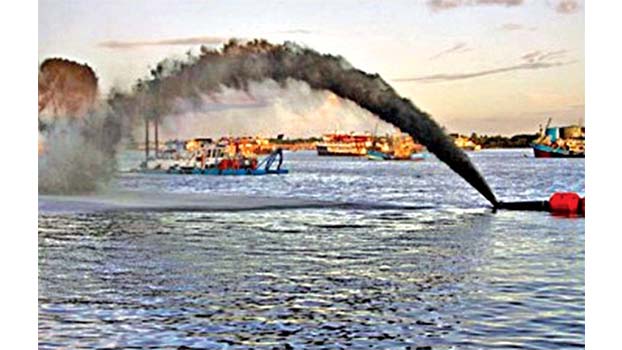Move to develop waterways

The government has taken up various measures to make the country’s waterways more navigable, sources in the shipping ministry said.
The shipping ministry has already embarked on massive dredging activities in a bid to restore the navigability of the river routes throughout the country.
According to the shipping ministry, dredging activities are in progress to restore the navigability of 10,000-kilomtetre river way.
Besides, it has also started developing the infrastructures of sea ports, land ports and important channels.
Considering the significance of infrastructure related sea-river-land ports and their efficient operational system in expanding international and domestic trade, the government is implementing a massive action plan to conduct capital dredging to modernise the country’s seaports.
Alongside the river ways, development of necessary infrastructure and facilities at the seaports are also in progress.
A Tk 17,000 crore project is being implemented to construct a bay terminal at Chattogram port.
The handling capacity of the Chattogram port will be enhanced significantly from present 2.8 million twenty-foot equivalent units (TEUs) to 3 million TEUs by the end of this financial year.
Besides, projects are being implemented to build necessary infrastructures and facilities at Payra sea port.
The construction work of Payra deep sea port at Kalapara in Patuakhali is making a steady progress. A tender to build the first terminal will be floated by September, officials said.
The port is the country’s 3rd and largest sea port and will add the much-needed port capacity to Bangladesh to enable larger vessels to call at the facility.
Among the main projects, works on the first terminal, a coal-fired power plant and dredging will start by the middle of this year. By 2021, international ships will be able to come to the terminal directly.
On the other hand, as the Mongla port is already a profitable and busy port with enhanced foreign ship anchoring, cargo handling, and high exports and imports in the last ten years and six months, the government is also working to enhance capacity of the port.
The projects include construction of four jetties and two yards, a large multi-storeyed garage for car parking, four lanes road, purchasing of 11 survey and tag boats and modern machineries for handling cargoes and containers.
On the other hand, a ‘comprehensive effort’ will be made to protect all rivers, canals, haors and other water bodies as the country’s agriculture and rural economy are dependent on them.
The country has some 405 rivers of which 57 trans-boundary rivers.
Due to climate change and different natural and man-made problems, the country’s rivers and water bodies are being polluted gradually.
Around 77 rivers have totally disappeared from the map of Bangladesh, with their beds serving as croplands, according to experts.
“Rivers are disappearing due to the unplanned construction of embankments and culverts, unabated encroachment, the absence of dredging, lack of water flow, urbanisation, siltation, earthquakes, climate change and construction of barrages and withdrawal of water with the construction of dams in the upstream,” Abu Naser Khan, chairman of Paribesh Bachao Andolon (POBA), told Bangladesh Post.
According to him, the government has formulated NRCC Act 2013 to prevent grabbing of rivers, pollution and establishing of illegal structures, retrieve natural flow of river, proper maintenance of rivers and make rivers as favourable to shipping to ensure the rivers multidimensional use for the socioeconomic development of the country.
Meanwhile, State Minister for Shipping Khalid Mahmud Chowdhury said dredging of 25 rivers are now underway including the dead and dry rivers in order to keep the navigability of the river route throughout the country.
“The dredging of 25 rivers are now going on ….it will continue till 2026,” the state minister said.
Of the total rivers under dredging, he said, 13 are dead and dry rivers. The dead and dry rivers are Kongso river, Mogra, Chalti, Dudkumar, Rokti, Baulai, Rakshaw-Nalar river, Arial kha, Monu, Atrai, Buri, Natun river and Moynakata river.
Many rivers like the Chitra, Daudkhali, Chengrail, Ghanoraj, Betna, Mukuleswari, Labangabati, Herther, Atharobeki, Salta, Dakua Khal, Sui, Dhanu, Balardi, Phutki, Mora Kumar and Muchikhali have completely vanished from Bangladesh’s map.
Besides, most portions of rivers like the Padma, Ganges, Teesta, Brahmaputra, Jamuna, Dhaleshwari, Sandhya, Meghna, Buriganga, Shitalakhya and Bangalee have already dried up because of the irresponsibility of local residents and the government’s negligence, complained green activists and river experts.
About 45 rivers like the Kaliganga, Bangshi, Banar, Patnai, Jadukatha, Manu, Mogra, Dakatia, Dhorla, Old Brahmaputra, Mohananda, Arialkha, Gorai, Hura Sagor, Karotoa, Bibiana, Pagla, Rakti, Dakua, Barak, Patnai, Kangsha, Turag, Nabaganga, Ichamati, Madhumati, Dumuria, Someswari, Balu, Jamuneswari and Dhaleswari are about to die, an expert said.
The length of internal river routes of the country is 6,000 kilometres during the monsoon and 4,000 kilometres in the dry season, according shipping ministry sources.
About 1,620 km of river routes have totally disappeared. Farmers are now cultivating crops on these lands.




